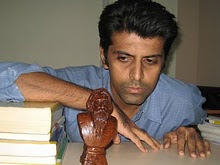"Work On Your 'Black Magic'!"
As the few readers of mine know, I just wrote about a brush with the occult (the last post here; it was rather more than a brush, physically speaking, but that is not the story now!). And while keying in that story, I remembered another piece that I wrote nearly half a generation ago - in perhaps my first ever attempt to write anything beyond examination essays.
As some would know, I was, once upon a time, a research student of Physics. Our hostel had a bit of a tradition of folks putting up articles on the notice-board. Driven mostly by "Why can't I too...?" sentiments, I put up a piece titled "Magic and Black Magic in Kerala: a living tradition".
Now, in hindsight, I could say, that article laid down a template which most posts here have ended up following - a personal memory-rewind with anecdotes, historical and literary episodes gathered from here and there, (where available) a couple of quotes and personal experiences thrown in and ...
Further, as has been the case with most posts here, readership was low then. Anyways...
Some months down the line, my research career, which had never really been on a roll, began showing signs of sputtering to a halt. I had a conversation with a senior colleague.
Him: Must say, time is running out, you got to either pull yourself up by your boostraps or...
(pauses briefly)
Him: This might sound radical but... have you thought about other ... options?
Self: Options ... like?
Him: Hmm, alternative career paths, some other...
Self: No. I understand things have not gone well, they are not looking too good either but I sort of try to tell myself that I am not all that bad and if I hold on for a while and...
Him: That would have been fine if you had say 3-4 years ahead, but... I sense a sort of disconnect. Like... You know, I would put it this way, you are not really cut out for the exact sciences!
Self: In what sense?
Him: You know, in Maths or Physics, you need to think very logically, very analytically; one has to be sharply analytical to do well. Your thinking... you are not really analytical and precise enough, like, you are more ... emotional.
(continues after a pause)
Him: Actually, you probably would make a decent writer, er... the freelance journalist type. There you can be vague and general and flowery, at least there is no need to be really rigorous! I remember you wrote that bit about black magic and stuff. It was actually pretty good. Why don't publish it in some newspaper? That could show you an alternative career path. Well, I am not saying what you wrote is great or anything, but I remember seeing some potential there.... Yes, you should try that. Work on your Black Magic, rewrite it into a proper essay, see what experts in that field say about it and then, you could ... you know...
As some would know, I was, once upon a time, a research student of Physics. Our hostel had a bit of a tradition of folks putting up articles on the notice-board. Driven mostly by "Why can't I too...?" sentiments, I put up a piece titled "Magic and Black Magic in Kerala: a living tradition".
Now, in hindsight, I could say, that article laid down a template which most posts here have ended up following - a personal memory-rewind with anecdotes, historical and literary episodes gathered from here and there, (where available) a couple of quotes and personal experiences thrown in and ...
Further, as has been the case with most posts here, readership was low then. Anyways...
Some months down the line, my research career, which had never really been on a roll, began showing signs of sputtering to a halt. I had a conversation with a senior colleague.
Him: Must say, time is running out, you got to either pull yourself up by your boostraps or...
(pauses briefly)
Him: This might sound radical but... have you thought about other ... options?
Self: Options ... like?
Him: Hmm, alternative career paths, some other...
Self: No. I understand things have not gone well, they are not looking too good either but I sort of try to tell myself that I am not all that bad and if I hold on for a while and...
Him: That would have been fine if you had say 3-4 years ahead, but... I sense a sort of disconnect. Like... You know, I would put it this way, you are not really cut out for the exact sciences!
Self: In what sense?
Him: You know, in Maths or Physics, you need to think very logically, very analytically; one has to be sharply analytical to do well. Your thinking... you are not really analytical and precise enough, like, you are more ... emotional.
(continues after a pause)
Him: Actually, you probably would make a decent writer, er... the freelance journalist type. There you can be vague and general and flowery, at least there is no need to be really rigorous! I remember you wrote that bit about black magic and stuff. It was actually pretty good. Why don't publish it in some newspaper? That could show you an alternative career path. Well, I am not saying what you wrote is great or anything, but I remember seeing some potential there.... Yes, you should try that. Work on your Black Magic, rewrite it into a proper essay, see what experts in that field say about it and then, you could ... you know...

